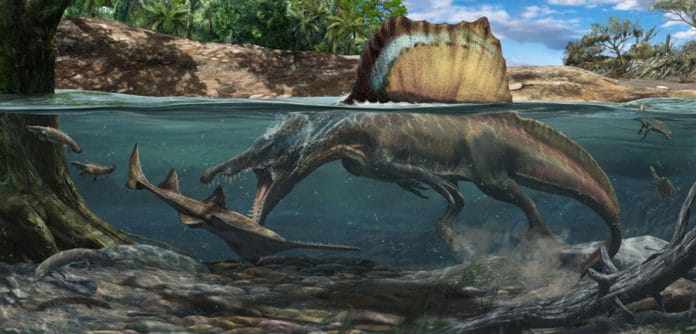Spinosaurus was among the largest carnivorous dinosaurs ever discovered. They look like T. rex but with a long, narrow snout and short legs. Originally discovered in 1915, it includes species like Spinosaurus from northern Africa and Baryonyx from England. They weigh around 7 tonnes, with a sizeable crest-like sail across its back.
A multi-institution team’s recent study, including the Field Museum of Natural History, Chicago, the University of Oxford, and the University of Cambridge, suggests that some dinosaurs from the spinosaurid family swam underwater to search for prey.
Using an X-ray imaging technique on fossilized bones, scientists analyzed their bone density. They then compared the bone structure of living animals and birds that hunt in the water. They demonstrated strong evidence that dinosaurs from the spinosaurid family swam underwater to search for prey.
Based on fossilized gut contents, spinosaurids were assumed to be amphibious hunters, eating surf and turf. However, the topic of debate was- whether they caught fish in the water like a crocodile or hunted from the shallows like a heron.
Considering their long snout and tail fin, some paleontologists used to believe that spinosaurids were specialist aquatic predators. But, fossil footprints show that most dinosaurs walked on land, and evidence for swimming is rare.
To solve this puzzle, scientists in this study used data on skeletal bone density. Scientists used CT scanning to collect femur and rib bone cross-sections from more than 200 living animals, including those that hunt in the water like otters and those that forage on land like badgers. The data was then compared to many dinosaurs, including three spinosaurids: Spinosaurus, Baryonyx, and Suchomimus.
The outputs showed that animals that submerge themselves underwater to hunt food have completely solid bones, while cross-sections of land inhabitants’ bones resemble doughnuts with hollow centers.
Co-author Professor Roger Benson, Department of Earth Sciences, University of Oxford, said, “Animals that search for food underwater have the high bone density to help them stay submerged without spending too much energy, including hippos, sea lions, cormorants, and crocodiles.”
Lead author Dr. Matteo Fabbri, Field Museum of Natural History, Chicago, said, “We found a very strong correlation between bone density and underwater foraging. This means that all the animals that have the behavior where they are fully submerged have these dense bones, and that was the great news because it allows us to test which dinosaurs were swimming underwater.”
The Spinosaurus and Baryonyx had dense bones associated with full submersion, whereas their close relative, Suchomimus, had hollower bones. It still lived by the water and ate fish, as evidenced by its crocodile-mimic snout and conical teeth, but it was not swimming to hunt based on its bone density.
Dr. Fabbri said, “One of the big surprises from this study was how rare underwater foraging was for dinosaurs. We only found evidence for this in spinosaurids, and their behavior was much more diverse than we had thought.”
“Dinosaurs are mysterious and inspiring animals, but we only have their bones, and most skeletons are incomplete. Our study shows how much extra we could know about dinosaurs using analysis of living animals. In the future, we expect this approach to continue giving new insights about dinosaurs and their world.”
Journal Reference:
- Fabbri, M., Navalón, G., Benson, R.B.J. et al. Subaqueous foraging among carnivorous dinosaurs. Nature (2022). DOI: 10.1038/s41586-022-04528-0
